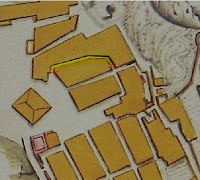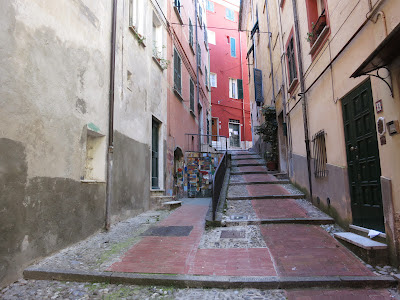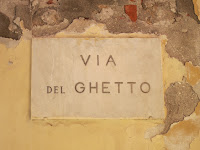A Piece of Jewish History in Italy in a Small Ligurian Town
 |
Lerici, Liguria c. 1773 Matteo Vinzoni.
|
Jews in Lerici History
The presence of Jews in Lerici dates at
least from the 15th century as shown by family names in the town archives. This evidence indicates that the Lerici
mayor in 1487, Giovanni de Saulo,
was Jewish. This region was not an
especially desirable location for Jews in 15th, 16th,
and 17th centuries. The Republic of Genoa, of which Lerici
was a part, was decidedly ambiguous in its attitudes, expelling Jews
from the city in 1545-1550, and from all its territory in 1567.
Subsequently, it allowed the establishment of ghettos in Genoa
beginning in 1660, but not due to an enlightened change of attitude - an outbreak of the plague in 1656-57 killed
as many as half of Genoa's population.
 |
| The older part of Lerici seen from its Castle. The San Rocco bell tower was originally a Roman watchtower. |
 |
| Via del Ghetto. Click to enlarge. |
 |
| At night an iron gate at this arch locked Lerici's Jews in the ghetto. |
The Ghetto
The exact scenario of the establishment of the Lerici ghetto is not documented, due to missing and destroyed town records, but it was around 1676. The ghetto was located entirely on Via del Ghetto, and it was originally a giudecca (Jewish neighborhood) before it was required to be a ghetto. Via del Ghetto is just off Piazza Mottino which is off the large Piazza Garibaldi. From the waterfront, it's behind the yellow building with a restaurant called '1918' and near the restaurant 'Da Louisa'.
 |
| Via del Ghetto, Lerici. Empty of people, but crowded with memories. |
Occupations
The livlihoods of ghetto residents
would have been diverse. In many Italian communities, Jewish lenders
were invited to begin doing business (since Christians were
prohibited from charging interest), and this introduction lead to the
arrival of other Jews practicing different trades, such as tailors,
doctors, traders, tutors, embroiderers, etc. This was probably part
of the pattern in Lerici, but records also show other activities.
Several citations, including one from 1839, record that the tanning
of skins was one of the principle activities, and a distinctive
concave piece of marble designed for holding skins during scraping
was found during the renovation of another house in Via del Ghetto.
 |
| The uphill gate of the ghetto was located here at Salita Ravellino. |
The last Jewish family residing on Via
del Ghetto was that of Salomone Funaro, originally from Livorno, who
operated a clothing store into the beginnings of the 20th
century. Today it is estimated that only 530 to 700 of Liguria's 1,642,000 residents are Jewish, almost certainly fewer than 300 years ago.
Visiting Lerici
For a broad description of Lerici, see our popular story Castle to Castle Along the Gulf of the Poets
Travel Tip_____________________________________________________________________
Renting A Car in Italy. If you drive in urban areas at home, you can drive in Italy. Car rental prices are important, but don't rent based solely on low price and stick to well known companies. We have two articles to help you: Link: Independent Car Rental Reviews for Italy and Link:Car Rental Tips for Italy - Pick It Up Right
In them, we recommend the car hire broker Auto Europe where you can compare companies, reserve with a low price guarantee, purchase no deductible insurance, cancel easily, and have 24/7 customer service before and after the car hire. If you will rent a car and want to do us a favor, please use this link: Auto Europe.
In them, we recommend the car hire broker Auto Europe where you can compare companies, reserve with a low price guarantee, purchase no deductible insurance, cancel easily, and have 24/7 customer service before and after the car hire. If you will rent a car and want to do us a favor, please use this link: Auto Europe.
__________________________________________________________________________________
Visiting Jewish Italy
The history of Jews in Italy is as fascinating as it is complex and poorly documented. Jews were present in Rome and other parts of the Roman empire starting around the 2nd century BC. There were Jews in small numbers in only a couple dozen Italian cities until the 12th century. In the following centuries, Jews appear in slowly growing numbers in a hundred or so Italian cities. If you are visiting Italy, here are some ideas.
Copyright 2012-2019 www.apathtolunch.com. All Rights Reserved. This article appeared on www.apathtolunch.com and has not been authorized elsewhere.
Venice. The first Jewish ghetto was in Venice, and today it still has a Jewish presence. The name ghetto came from the Venetian dialect word for foundry and was the name of the island where the ghetto was established. There is the small Jewish Museum of Venice - a tour of which includes visits to three of Venice's five synagogues. The neighborhood is relatively free of tourists, has some nice cafes and galleries and such, and has a peaceful, historic atmosphere that many people enjoy. There's an excellent article on ghetto life on the website, Europe for Visitors, Venice Ghetto.
Pisa. Just beyond the city wall from the Leaning Tower, the Duomo, and the Baptistry is the Jewish Cemetery (Cimitaro Ebraica) visitable on Sunday morning (10-12:30) and Wednesday afternoon 16:00-18:00 June-Oct, 14:00-16:00 Nov-May. According to the local Jewish community's Italian website Pisa Ebraica, Pisa is one of the world's oldest Jewish burial sites. The present cemetery dates from 1674, and it was preceded by three others with origins dating to the 1200's. Here's a nice article about the cemetery by a local blogger: At Home In Tuscany.
The history of Jews in Italy is as fascinating as it is complex and poorly documented. Jews were present in Rome and other parts of the Roman empire starting around the 2nd century BC. There were Jews in small numbers in only a couple dozen Italian cities until the 12th century. In the following centuries, Jews appear in slowly growing numbers in a hundred or so Italian cities. If you are visiting Italy, here are some ideas.
Copyright 2012-2019 www.apathtolunch.com. All Rights Reserved. This article appeared on www.apathtolunch.com and has not been authorized elsewhere.
Venice. The first Jewish ghetto was in Venice, and today it still has a Jewish presence. The name ghetto came from the Venetian dialect word for foundry and was the name of the island where the ghetto was established. There is the small Jewish Museum of Venice - a tour of which includes visits to three of Venice's five synagogues. The neighborhood is relatively free of tourists, has some nice cafes and galleries and such, and has a peaceful, historic atmosphere that many people enjoy. There's an excellent article on ghetto life on the website, Europe for Visitors, Venice Ghetto.
Pisa. Just beyond the city wall from the Leaning Tower, the Duomo, and the Baptistry is the Jewish Cemetery (Cimitaro Ebraica) visitable on Sunday morning (10-12:30) and Wednesday afternoon 16:00-18:00 June-Oct, 14:00-16:00 Nov-May. According to the local Jewish community's Italian website Pisa Ebraica, Pisa is one of the world's oldest Jewish burial sites. The present cemetery dates from 1674, and it was preceded by three others with origins dating to the 1200's. Here's a nice article about the cemetery by a local blogger: At Home In Tuscany.
 |
| Pitigliano in Tuscany has a unique Jewish history. |
Rome. Historically prominent, the Rome ghetto is now a trendy neighborhood with only modest reminders of its history. Many people enjoy the Jewish Museum of Rome and the Rome Synagogue. The guide Micaela Pavoncello is very well regarded and has a useful website Jewish Roma. For the basics, there's Rick Steves on the Rome ghetto
Ferrara. While the Jewish presence in Ferrara has a long history, there is just a small
neighborhood that was the ghetto and three synagogues (with limited hours). However the new National Museum of Italian Judaism & the Shoah has made Ferrara a worthwhile stop for anyone interested in Jewish history. The city is also special to those who enjoyed the 1971 De Sica film, The Garden of the
Finzi-Continis, based upon the book by Georgio
Bassani. The film is a must for anyone interested in good films or the social history of Jewish Italy. For practicalities, see this Trip Advisor post.
Numerous other Italian cities have aspects of Jewish heritage for those who are historically oriented and imaginative - your research will be rewarded.
Sources
For an overview of Italian Jews and their history, Wikipedia has two good articles. Italian Jews and History of the Jews in Italy
Two presentations in Italian “La comunità ebraica di Lerici” by Alessandro Manfredi to the Circolo Rotonda of Lerici were of great help. Part 1 La comunita ebraica Part 2. La comunita ebraica Mr. Manfredi developed an interest in Judaism and Jewish history after hearing of the discovery of the scrolls in the ex-Synagogue in his youth.
Two presentations in Italian “La comunità ebraica di Lerici” by Alessandro Manfredi to the Circolo Rotonda of Lerici were of great help. Part 1 La comunita ebraica Part 2. La comunita ebraica Mr. Manfredi developed an interest in Judaism and Jewish history after hearing of the discovery of the scrolls in the ex-Synagogue in his youth.
An article titled Una Ricerca sul Ghetto by Valerio Botto in the newsletter, “Lerici In...” February, 2009, supplied additional information.
We thank Gino Cabano for the Vinzoni maps. Facebook Storie-e-Notizie-del-Monte-Caprione-di-Lerici
Written by Martha


